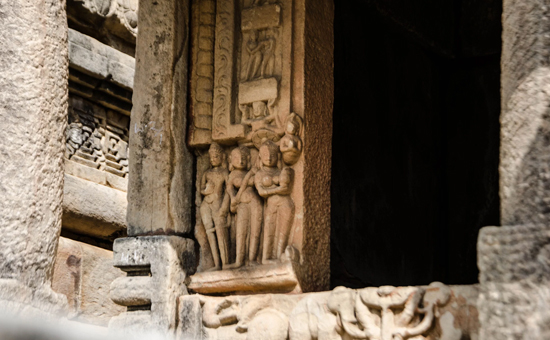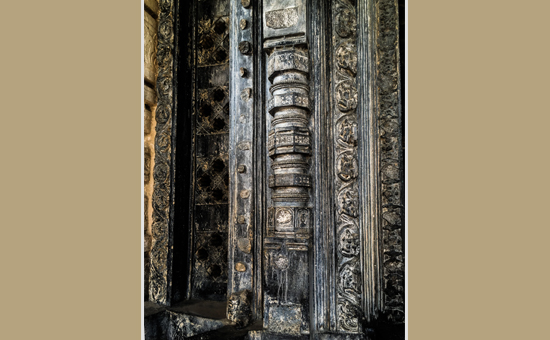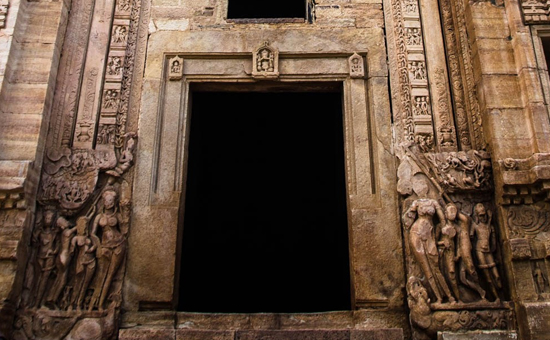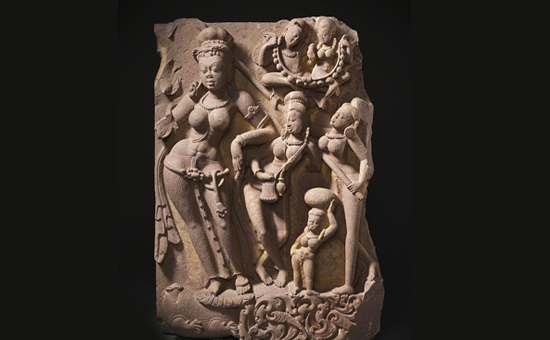- Article explains the sculptures and motifs on the doorway
to a temple sanctum.
A Hindu temple is a structure where sculptures abound
on the outer wall surfaces, in the various halls or mandapas, on pillars,
ceilings, and also on the shikharas/vimanas. However, such profusion of
carvings end abruptly as one crosses the threshold of the sanctum, and enters
it.
The sanctum or garbhagriha,
also known as prasada, is a dark,
cuboidal chamber inside the temple, and remains deprived of any artwork, except
for the murti of the presiding deity or a symbol of the deity.
As a bhakta enters the temple with his mind focused on
viewing the deity installed inside the prasada, he too becomes a part of the
architecture as he stands to gaze or pay obeisance to the various sculptures
spread across the mandapas that guide him slowly towards the garbhagriha.
These exquisite carvings come to an abrupt halt at the
doorway to the prasada, and the bhakta sees them for the last time crowding the
door jambs, the dwara sakhas, and lintels. As he steps inside or peers from
outside into the darkness of the prasada with its stark empty walls, he finds
nothing there to take his mind away, and his entire focus now centers on the
divinity that stands inside.
 Baseswara Temple, district Kullu.
Baseswara Temple, district Kullu.
Detail
Caption - The blue wings of the door to the garbagriha (Baseswara temple, Bajoura village in
district Kullu, Himachal Pradesh)
 Sri Erakeswara temple, Telengana.
Sri Erakeswara temple, Telengana.
Detail Caption - In larger temples a
bhakta crosses various pillared mandapas to reach the sanctum. Seen here is the
nritya or ranga mandapa, in the Sri Erakeswara temple, Pillalamari village,
Telengana.
As a bhakta approaches the prasada or
sanctum, he is met with a framed doorway that follows geometric proportions as
given in the Brihatsamhita. He sees
the winged doors, a threshold below it, two doorjambs on two sides of the
threshold, vertical mouldings or antepagments above the door jambs
known as sakhas, and the horizontal top beam or lintel.
 Chausath
Yogini temple, Madhya Pradesh
Chausath
Yogini temple, Madhya Pradesh
Detail caption - The threshold shows a now weathered lotus motif, while the horizontal beam or lintel depicts a worn out Lakulisha
at its centre, and the two river devis adorn the door jambs along with the
dwarapalas. Seen here is a chamber inside the Chausath Yogini temple in
Morena, Madhya Pradesh.
Generally it is seen that the deity inside and the
door to the sanctum are closely related, wherein his image is carved on the
lintel at the centre; while his dwarapalas (their weapons signifying the main
deity inside) stand guard two on two sides of the door jambs.
On the thresholds there are carved long stemmed lotus
flowers, symbolising the divinity of the universe, and also the emotionless mind
necessary to reach divinity. The priest and the bhakta entering the garbagriha
must cross the threshold without treading on it. As one enters the sanctum, he
or she is also raised to the status of the divinity, and the sculptures on the
door of the sanctum help the priest and the bhakta to undergo that change.
 Bateswara temple, Madhya Pradesh.
Bateswara temple, Madhya Pradesh.
Detail caption - Long stemmed lotus on threshold with two elephants flanking it. While the lotus motif is fixed, the other components on two sides may vary. There may be depicted deities, animals, and kirtimukahs too. The photo is of a shrine inside the Bateswara temple complex in Morena, Madhya Pradesh.
 Neelkanth temple, Ajmer.
Neelkanth temple, Ajmer.
Detail Caption - Seen here is the sculpture of Shiva (Neelkanth
temple in Alwar, Rajasthan) at the
centre of the lintel, which is a manifestation of the presiding deity inside
the sanctum. Often navagrahas or the nine planets are sculpted on the
lintel panels on two sides of the main deity to denote the celestial world;
while sometimes the trinity is also carved on the two end and the central
niches on the lintel beam, with the presiding deity occupying the central niche. The presiding deity is also sometimes replaced
with the image of Lakshmi or Gajalakshmi, where initiation or Diksha (the ritual
bath before entering) is given greater importance.
In most Indian temples, on two sides
of the two door jambs generally stand the two river devis: Ganga and Yamuna
with their retinues, while above them are the dwara sakhas. The term sakhas denote branches, and it is
believed that originally a number of branches were held and tied together to
create a doorway to the deity, and the tradition was later artistically carried
on in form of stone vertical mouldings that now form the dwarasakhas. The
sakhas are always seen in odd digit numbers: 1, 3, 5, 7 or 9.
 Dwara
sakhas, Sri Erakeswara temple.
Dwara
sakhas, Sri Erakeswara temple.
Above the rivers devis are the carved sakhas. The sakhas are in the form of vertical
mouldings that with their sculptural motifs denote youthfulness and lives
nurtured by these river waters.
Thus, we see sakhas with creepers, vines, flowers,
leaves, mithuna couples, prancing yalis, and happy faces of baby like ganas
arising triumphantly from the river devis standing on door jambs. These rivers,
which originate from heaven, possess celestial powers, and as one crosses them,
he or she undergoes the ritual bath, which symbolises ablution and an
initiation to attain divinity. The sacred waters in their celestial state thus
wash away human sins; akin
The sanctum doors thus form to be the sculptural
representations depicting the descent of the holy waters from heaven, and the
subsequent rise of lives from them. The river devis not only help life to
thrive, but they also foster the garbha (embryo) of the temple; while the
dwarapalas on two ends of the door jambs protect the new lives arising from the
river devis, and most importantly help to preserve the sanctity of the temple
embryo
 Bateshwar temple, Madhya Pradesh.
Bateshwar temple, Madhya Pradesh.
Detail caption - The river devis on door jambs are often depicted without their water
pots and vahanas. Often nagas and ganas
accompany the river devis, as they form a part of the water world. The
appearance of the two devis in temple iconography starts from around early
Common Era (early Gupta period), prior to which floral scrolls were
mostly seen on door jambs. There also instances of a yakshi shown riding a makara and vanadevis flanking the door jambs. Seen here are the river devis Ganga and Yamuna, without their vahanas on a door jamb in a shrine inside the Bateswara temple in Morena, Madhya Pradesh.
 Teli ka Mandir, Gwalior fort.
Teli ka Mandir, Gwalior fort.
The two
river devis: Ganga stands on the right side of the door jamb on makara (her
vahana), while Yamuna is on the left side on a turtle (her vahana). On their
sides are their attendants, while the dwarapalas stand at the two ends. The dwarapalas
show the attributes of the presiding deity inside the sanctum.
The devis which rise from heaven (the dark cell inside) give birth to and
nurture new lives;
while the
dwarapalas stand as protectors warding of all evil and preventing contamination
of the seed and embryo (garbha) of the temple.
(Teli ka mandir, Gwalior fort).
 Yamuna on her turtle. Source: wikipedia
Yamuna on her turtle. Source: wikipedia
Thus, for
a bhakta entering the temple sanctum, the garbagriha door is not only a
manifestation of the main deity inside, but it is also a point of initiation; a
teerth by itself, which removes all his sins, wards off evil, flourishes life,
and provides him with a changeover from his human form to achieve divinity for
as long as he crosses the threshold and stays inside the sacred dark chamber.
References
1. Kramrisch Stella. 2013. Indian Sculpture. Motilal Banarasidass, Delhi
2. Gupta, S., and Asthana, P.
S. 2002. Elements of Indian Art. Indraprastha
Museum of Art and Archaeology, Delhi.
To read all articles by author
Author studies life sciences, geography, art and international relationships. She loves exploring and documenting Indic Heritage. Being a student of history she likes to study the iconography behind various temple sculptures. She is a well-known columnist - history and travel writer. Or read here
Article
was first published on author’s blog and here Article and pictures are courtesy and
copyright author.